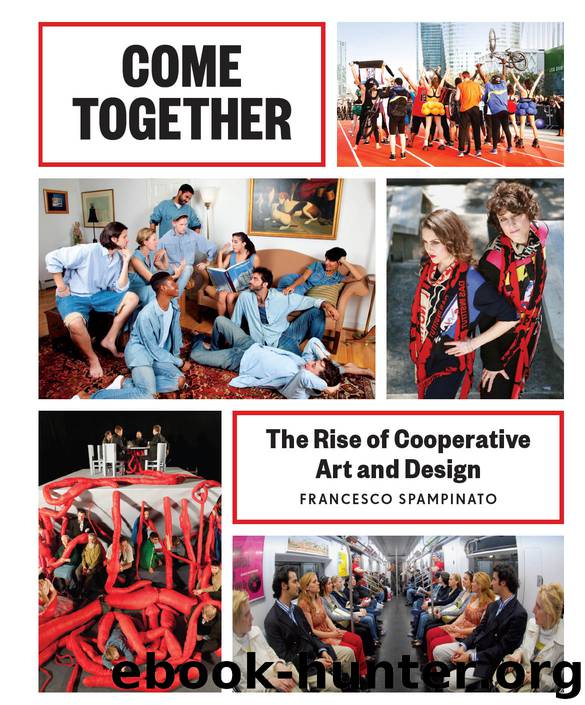Come Together by Francesco Spampinato

Author:Francesco Spampinato [Francesco Spampinato]
Language: eng
Format: epub
Publisher: Princeton Architectural Press
Published: 2015-03-14T04:00:00+00:00
1 – Feeling So Much Yet Doing So Little, installation, Western Front, Vancouver, 2012
How are decisions made?
It Doesn’t Have To Be Good To Be Meaningful
It varies from project to project. There are shifting heads. But generally if a member can rally the interest and support of enough of the other members, then the project is a go. Not everyone works on everything and not everyone has to agree on everything.
Does each of you have a clearly defined role? If so, what are some of each member’s distinct responsibilities?
Waiting For Something To Happen.
Of course we each have our unique offerings, but nothing is clearly defined or assumed.
How important is each group member’s individuality, both in terms of your artistic production and in terms of your relationship with the media? Does anonymity come into play?
There Is No Romance In Taking A Risk.
Maybe it isn’t so important to speak about individuality in this context. We acknowledge our relations to the collective as a part of it. This is not to say that each of us doesn’t retain value. We all factor in, but always and only as pieces, and as pieces we have to be perceived within a larger whole.
What is the relationship between your working methods and your art’s “content”? In this sense, does technology tend to play more of a supporting role, or does it lead you in new directions?
Feeling So Much Yet Doing So Little.
Generally we don’t separate form and content. We use a lot of fluorescent orange/pink in our work not simply because we’re drawn to it but because we’re interested in exploiting its vernacular uses in advertising and as a utilitarian safety measure. In past installations, we used a lot of woven afghan blankets typical of North America in the seventies. We used them because they were colorful and easily commanded an aesthetic presence, but we were also interested in their economy as a laborious craft and their ready availability in secondhand stores.
And yes, how we work is an important part of the content. As a collective, we are dependent on the work of others. We often invite other artists to work with us, staging scenarios in order to incorporate their work with ours. Many of our exhibitions have functioned as venues for us to program music, performances, lectures, and screenings by other artists.
How does your collaboration relate to its cultural, institutional, and commercial contexts? In other words, how would you respond to those who call this a trend?
We Can Not Be Moved.
As we mentioned in our first response, we come from a long history of collaborative practices. It is a common means of working in Canada and we can draw a longer line through broader art history, naming arts and crafts movements from the Bloomsbury group to the artists working in Worpswede, Germany, in the early twentieth century. We could stretch our thinking to include the Constructivists and Dada, but if we look locally and nationally we can talk about Image Bank, the Western Front, and General Idea, all of whom have had an impact on us.
Download
This site does not store any files on its server. We only index and link to content provided by other sites. Please contact the content providers to delete copyright contents if any and email us, we'll remove relevant links or contents immediately.
Wonder by R.J. Palacio(8446)
Mastering Adobe Animate 2023 - Third Edition by Joseph Labrecque(3758)
Unlabel: Selling You Without Selling Out by Marc Ecko(3587)
Ogilvy on Advertising by David Ogilvy(3503)
Hidden Persuasion: 33 psychological influence techniques in advertising by Marc Andrews & Matthijs van Leeuwen & Rick van Baaren(3472)
Drawing Cutting Edge Anatomy by Christopher Hart(3453)
The Pixar Touch by David A. Price(3362)
POP by Steven Heller(3307)
The Code Book by Simon Singh(3073)
The Art of War Visualized by Jessica Hagy(2943)
Slugfest by Reed Tucker(2937)
The Curated Closet by Anuschka Rees(2911)
Rapid Viz: A New Method for the Rapid Visualization of Ideas by Kurt Hanks & Larry Belliston(2832)
Stacked Decks by The Rotenberg Collection(2810)
365 Days of Wonder by R.J. Palacio(2751)
The Wardrobe Wakeup by Lois Joy Johnson(2731)
Keep Going by Austin Kleon(2696)
Tattoo Art by Doralba Picerno(2599)
Tell Me More by Kelly Corrigan(2591)
